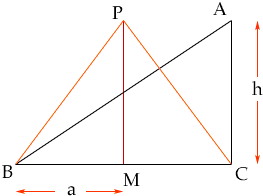![]()
I am a student (10-12) secondary.
Please could you tell me why for my coursework (where I have to find the largest area that a fence 1000m long can cover) why I should only test equilateral and isoceles triangles? We were told NOT to do right angled triangles but I was wondering why not?
Thankyou
very much
Petey
Hi Petey
Suppose that triangle ABC has a right angle at C and that the perimeter is 1000 m. Let M be the midpoint of BC. Construct an isosceles triangle PBC on the same base, BC, and with |CA| = |PM|. The triangles ABC and PBC have the same base and height and hence the same area. I want to show you that the perimeter of triangle PBC is less than the perimeter of triangle ABC.

Claim: |PB| + |CP| = 2 |PB| < |AB| + |CA|.
Since all the lengths are positive it is sufficient to show that
4 |PB|2 < (|AB| + |CA|)2
Let h = |AC| = |PM| and a = |BM| = |MC|. Using Pythagoras' Theorem,
|PB|2 = a2 + h2
and
|AB|2 = 4 a2 + h2Thus
(|AB| + |CA|)2 = |AB|2 + |CA|2 + 2 |AB||CA|
= 4 a2 + h2 + h2 + 2 h Sqrt( 4 a2 + h2)
> 4 a2 + 2 h2 + 2 h Sqrt(h2)
= 4 a2 + 4 h2
= 4 |PB|2
Thus the perimeter of triangle PBC is less than the perimeter of triangle ABC. Hence if you move P upwards to the place where the triangles have the same perimeter you have a new isoscelese triangle PBC with the same primeter as ABC but a larger area.
Cheers,
Penny